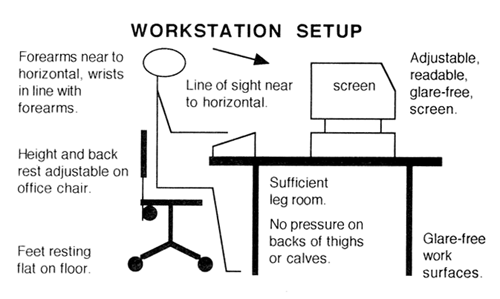
Unless operators of VDU's and desk-bound workers adopt good posture at their work, it is likely that headache and backache will become a regular occurrence. Whilst it may be tempting to slump into your chair the long term effects of poor posture will soon start to show. It is easy to avoid problems if you spend a little time thinking how you might adjust your work environment to suit your body.

Seat height should allow your feet to lie flat on the floor without the feeling that the edge of your seat is pressing into the backs of your thighs. Sit well back in your chair and ensure that the back of the seat holds the curve of your low back firmly.
If you do not have an adjustable seat, place a small cushion between your low back and the back of the chair in order that you do not slouch.
If you have a well adjusted sitting posture it will make it difficult to slouch and you will avoid straining your back.
Desk height should allow you, when sitting, to gently rest your forearms on the desktop without leaning forwards and upsetting your posture.
If you use a VDU the screen should be positioned so that it is at, or near, eye level. The keyboard is set up so that your elbows are close to your sides and the forearms are at right angles to the upper arm. In this position your fingers will rest gently on the keyboard with your wrists in line with the forearms.
You should stand and walk around at least once every half hour to avoid back and neck pain.